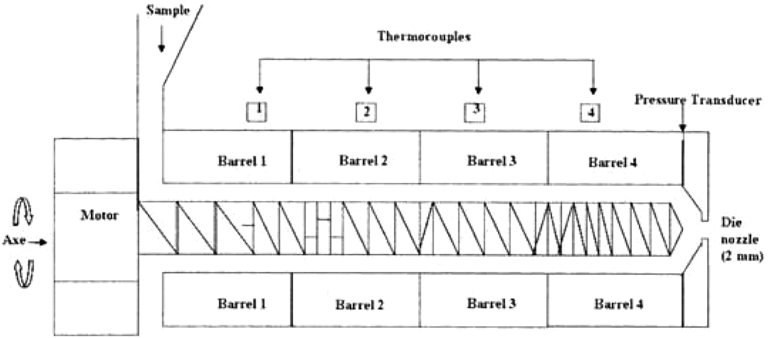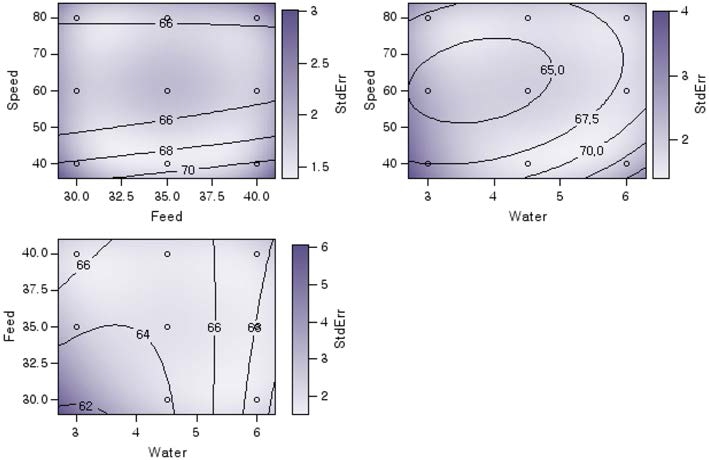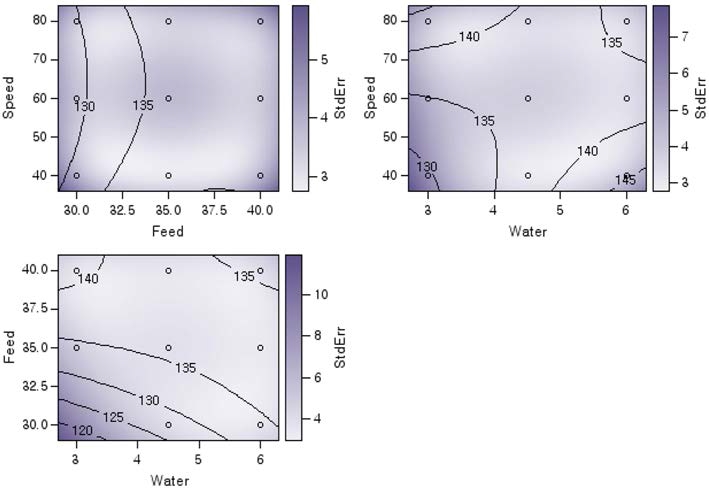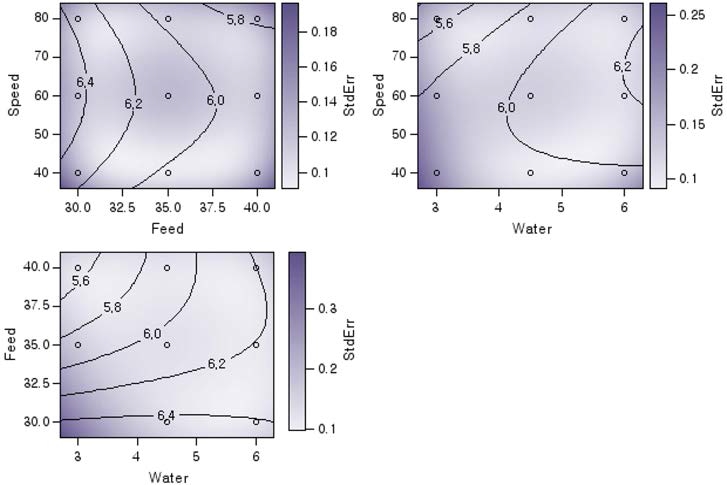
압출성형 공정에 따른 참당귀 추출물의 이화화적 특성
© The Korean Society of Medicinal Crop Science
This is an Open-Access article distributed under the terms of the Creative Commons Attribution Non-Commercial License ( http://creativecommons.org/licenses/by-nc/3.0 ) which permits unrestricted non-commercial use, distribution, and reproduction in any medium, provided the original work is properly cited.
Abstract
This study was designed to maximize extract yields of functional components in Angelica gigas Nakai by extrusion process. In addition, the optimizing condition of the extrusion process was established to increase the extraction of the functional components in A. gigas. The total polyphenol was increased by 40% compared to a control. And the optimizing condition was that the screw speed was 62.76 rpm, the amount of A. gigas powder was 34.79 ㎏/h, and the amount of water was 4.44 ㎏/h. The result of antioxidant activities of A. gigas extrusion, the inhibition of oxidization had the effect of 10.29 ~ 14.59% compared to a control. The content of decursin and decursinol angelate, which were index components, was 6.37%; it was increased by 16.64% compared to a control (5.31%) and showed a significantly difference (p < 0.05). And the optimizing condition was the screw speed 93.71 rpm, the amount of A. gigas powder was 28.67 ㎏/h, and the amount of water was 9.9 kg/h.
Keywords:
Angelica gigas Nakai, Decursin, Decursinol Angelate, Extract, Extrusion서 언
참당귀 (Angelica gigas Nakai)는 미나리과에 속하는 다년생 초본으로 참당귀, 승검초, 신감채라는 이름으로도 불리며, 강 원 평창, 인제, 홍천, 태백, 경북 봉화, 울진, 충북 제천, 단양, 전북 무주 등 각지의 해발 200-1500 m 되는 산골짜기의 습한 땅에서 자생한다 (Yu et al., 2007). 참당귀는 한방에서 빈혈 치료, 항균작용, 진정, 진통, 이뇨, 자궁기능조절, 비타민 E 결 핍증 치료, 혈액순환장애로 인한 어혈증과 혈전증, 반신불수 등에 처방되는 중요한 생약이다 (Ahn et al., 1995; Han et al., 1998; Kim et al., 1980; Matsumoto et al., 1998; Ye et al., 2001). 현재 우리나라에서 유통되고 있는 당귀는 참당 귀, 일당귀 및 중국당귀의 3종이 있으며, 최근에는 중국에서 수입된 당귀가 많이 유통되고 있는 실정이다. 당귀는 대표적 인 보혈제의 원료로써 한국, 중국 및 일본에서 처방되는 한약 재중 하나이나 기원이 서로 상이한 것을 약으로 이용하고 있다. 국내산 참당귀가 중국당귀 및 일본당귀와 비교해 유용 성분 (decursin 및 decursinol angelate)이 더 많이 함유되어 있는 것으로 보고됨에 따라 우리나라에서 재배되고 있는 참당 귀가 주목받고 있으며 (Seong et al., 1993), 최근에는 친환경 유기질 비료를 이용한 참당귀 재배 등 수량 증대를 위한 다양 한 연구를 진행하고 있다 (Kim et al., 2014)
참당귀의 효능으로는 진경작용, 혈압 강화 작용, 진통작용 (polyacetylene계), 항 염증작용 (β-sitosterol-D-glucoside) (Cho et al., 1982), 항 acetylcholin작용 (phthalide계), 해열작용, 수 면 연장 작용, 혈소판 응집 억제 작용 (adenosine, ligustilide, butylphthalide)이 보고되고 있으며, coumarin계의 decursin, decursinol, decursinol angelate, nodakenetin, nodakenin, umbelliferone, β-sitosterol, α-pinene, limonene 등이 함유되어 있다 (Kim et al., 2009, Hwang et al., 1997; Ryu et al., 1990). 참당귀는 생리활성과 면역력 증진, 고분자 용액 특성 및 식이섬유소 등과 같은 기능특성을 제공하기 때문에 기능성 식품소재로 이용되고 있다 (Kelly et al., 1999). 따라서 참당 귀 유용성분의 용출을 극대화시킬 수 있는 추출법이 확립되어 야 한다. 일반적으로 식물의 세포벽은 셀롤로오즈, 헤미셀룰로 오즈, 팩틴, 리그닌, 다당류 등의 고분자 물질로 구성되어 있 으며, 이들 각각의 성분들이 상호간에 이온결합, 공유결합, 수 소결합 등을 통해 서로 치밀한 결합 조직을 이루고 있다 (Kim et al., 2007).
따라서 참당귀 중 유용성분을 최대한 용출시키기 위해서는 참당귀를 구성하고 있는 세포벽의 강한 결합 조직을 약화시켜 용매에 의해 용출시키는 것이 좋다. 특히, 세포벽을 수용화시 키기 위해서는 압착법, 환류추출법과 가압추출법 등의 전통적 인 추출방법이 널리 이용되어 왔으나 이러한 방법은 수율이 낮고 작동비용이 많이 드는 문제점과 열에 민감한 성분은 분 해되기 쉬운 단점을 가지고 있다.
압출성형은 단일 공정으로 반죽, cooking, 성형 및 살균이 이루어져 노동력 및 시간 절약에 이점을 가지고 있어 스넥, 크래커, 및 씨리얼 등을 제조하는 식품산업에 많이 이용되고 있다. 압출성형 처리를 이용한 식물 세포벽의 수용화에 관한 연구는 주로 물성의 개선을 위한 것이었다. 압출성형처리 중 에 발생되는 고열, 고압, 고전단력에 의해 고밀도 조직이 팽화 하여 밀도가 낮아지고 내부에 기공이 형성되어 부드러운 조직 으로 되면서 표면적이 증가하여 용매와 이온 교환력이 향상되 고 용해도가 높아지고 유용성분의 확산 속도가 증가한다. 특 히 수용성 성분의 용출이 용이해져 각종 유용성분의 추출 수 율이 증가하는 것으로 보고되고 있다 (Kim et al., 1997, 2005a, b; Ha et al., 2005; Ryu et al., 2004, 2007; Yoon et al., 2005). 또한 밀기울을 압출성형 처리하여 조직의 결합 력을 이완시켜서 수용성 성분의 증가와 구조적 변화에 의해 관능성과 물성이 개선되는 효과가 있는 것으로 보고되고 있다 (Hwang et al., 1994).
따라서 본 연구는 참당귀의 유용성분 및 다당류의 추출 증 대를 위한 압출성형의 최적조건 구명과 압출성형 공정변수 (온 도, 수분함량, 스크류 속도)에 따른 기능성분과 수용성 추출물의 수율 및 이화학적 특성분석을 수행하였으며, 압출성형 공정 처 리를 하지 않은 대조구로 하여 항산화 성분을 측정 비교 하였다.
재료 및 방법
1. 연구 재료
본 실험에 사용된 참당귀 (Angelica gigas Nakai)는 2009 년 강원도 진부에서 GAP 표준재배지침서에 따라 재배생산된 것으로 시중에서 판매되고 있는 제품을 구입하여 동결 건조한 후 60 mesh 미분쇄하여 4°C에 보관하면서 실험하였다.
2. 압출성형물 제조
압출성형 참당귀 미분은 쌍축압출성형장치 (DNDL-44, Buhler Brothers Co., Uzill, Switzerland)를 이용하여 지름이 3mm인 원형 사출구 하나를 열어 압출성형 하였다 (Fig. 1). 강한 층 밀림을 유도하기 위해 3개의 역방향 스크류를 조합하 였으며 참당귀 분말을 일정하게 (140kg/h) 투입하여 가수량을 변화시키며 압출성형 하였다. 이 때 바렐은 150°C 고정하여 유지하였다. 식물의 세포벽 성분을 수용화하기 위해서는 강한 전단응력 및 마찰열을 필요로 하기 때문에 압출성형 조건을 Table 1과 같이 설정하였다. 압출성형 시 온도와 압력을 측정 하고자 사출구와 스크류 전면사이에 열전대 및 변화기를 통하 여 압출성형 온도와 압력을 측정하였다. 요인변수에 따른 변화 양상은 압출온도와 기계적 소모 에너지 (Specific Mechanical Energy Input, SME)로 조사하였다. 또한 추출물의 특성을 최대 로 하는 추출조건을 설정하기 위해 반응표면분석법 (Response Surface Methodology, RSM)을 사용하였다 (Gontard et al., 1992). 추출조건에 대한 실험계획은 중심합성계획 (Central composite design)을 사용하였으며, 반응표면분석을 위해 SAS (Statistical Analysis System)를 사용하였다. 실험계획은 Table 2와 같이 추출공정에서 중요한 변수인 압출성형기의 스크류 속도 (40 ~ 80 rpm, X1), 원료 투입량 (30 ~ 40kg/h, X2), 가 수량 (3.0 ~ 6.0kg, X3)를 −1, 0, 1의 3단계로 부호화하여 중 심합성계획에 따라 Table 3과 같이 15구간으로 설정하여 추출 실험을 실시하였다. 또한 이들 요인변수에 의해 영향을 받는 종속변수 (Yn) 즉, 수율, 수분용해지수, 수분흡착지수, 총 폴리 페놀함량, 총 플라보노이드함량, DPPH 라디칼 소거능, ABTS 라디칼 소거능, decursin과 decursinol angelate 함량으로 하였 으며, 이들은 3회 반복 측정하여 그 평균값을 회귀분석에 사 용하였다.
3. 참당귀 압출성형물의 추출
참당귀 압출성형물의 이화학적 특성을 분석하기 위해 참당 귀 압출성형물 5 g을 고온 고압 추출장치 고압멸균기를 이용 하여 상온에서 95 mL 물을 가해 120°C에서 20분간 추출하였 다. 추출물은 3000 rpm에 5분 동안 원심 분리하여 얻은 상등 액을 추출액으로 하였다.
4. 참당귀 압출성형물의 이화학적 특성분석
수분용해지수 (Water Soluble Index, WSI)와 수분흡착지수 (Water Absorption Index, WAI)는 Anderson 등 (1969)의 방 법에 따라 구하였다.
5. 참당귀 압출성형물의 항산화성분 및 항산화 활성
총폴리페놀의 함량 측정은 Folin-Denis 방법 (1959)을 변형 시켜 실시하였다. 시료 0.2 mL에 증류수를 가하여 1 mL로 만 든 후, 여기에 0.1 mL의 Folin-ciocalteu's phenol reagent를 가하여 혼합하고 3분간 실온에서 방치하였다. Na2CO3 포화용 액 0.2 mL를 가하여 혼합하고 증류수를 첨가하여 2 mL로 만 든 후, 실온에서 1시간 방치하고 3,000 × g에 10분간 원심 분 리하였다. 상등액을 취해 725nm에서의 흡광도를 측정하였으 며, 총폴리페놀이 다량 함유되어 있다고 알려진 Catechin (Sigma-Aldrich, St. Louis, MO, USA)을 이용하여 작성한 표 준곡선으로부터 총폴리페놀 함량을 구하였다.
총플라보노이드의 함량 측정은 Davis 방법 (1995)을 변형하 여 측정하였다. 에탄올 추출 검액 0.2 mL에 90% diethylene glycol 2 mL과 1 N NaOH 0.2 mL을 혼합하여, 37°C 수조에 넣어서 1시간 동안 반응시켰다. 흡광도의 변화는 420nm에서 측정하였으며, Naringin (Sigma-Aldrich, St. Louis, MO, USA)을 이용하여 작성한 표준곡선으로부터 총플라보노이드 함량을 구하였다.
압출성형물의 DPPH radical 항산화 활성 측정은 Abe 등 (1995)과 Kim 등 (2013)의 방법을 변형하여 실시하였다. 100μm DPPH (2, 2-Diphenyl-1-picryl hydrazyl) 메탄올 용액 을 제조하여 여과지 (Watman No. 4)에 여과하여 준비하였다. 시료를 농도별대로 제조한 후 (0.1, 0.3, 0.5, 0.7, 1mg/mL), 0.1 mL에 DPPH solution 2.9 mL을 첨가한 후 23°C 암실에서 30분간 반응시킨 후 517nm에서 흡광도를 측정하였다. 항산화 효능의 대조구는 일반적으로 많이 알려져 있는 L-ascorbic acid와 비교실험 하였고 아래의 식으로 계산하였다.
SampleAbs: 추출물을 넣었을 때의 흡광도 값
Sample blankAbs: 추출물대신 동량의 증류수를 첨가했을 때의 흡광도 값
ABTS+ radical을 이용한 항산화력 측정은 ABTS+ cotion decolourisation assay 방법으로 Roberta 등 (1999)의 방법을 변 형하여 시행하였다. 7mM 2,2-azino-bis (3-ethylbenthiazoline- 6-sulfonic acid)와 2.45 mM potassium persulpate를 최종 농 도로 혼합하여 실온인 암실에서 12시간 이상 방치하여 ABTS+ 을 형성 시킨 후 734nm에서 흡광도 값이 0.7 ~ 0.8nm가 되 도록 희석하였다. 희석된 용액 990 μL에 시료 10 μL를 가하여 60분 방치한 후 흡광도를 측정하였다. 대조구는 일반적으로 많 이 알려져 있는 Ascorbic acid와 Trolox로 비교실험 하였으며 아래의 식으로 계산하였다.
SampleAbs: 추출물을 넣었을 때의 흡광도 값
Sample blankAbs: 추출물대신 동량의 증류수를 첨가 했을 때의 흡광도 값
6. 지표성분 함량 측정
각 시료의 20mg을 정확히 취하여 80% 메탄올 1 mL에 초 음파추출기를 사용하여 20분간 추출액을 4,000 × g, 18°C에서 10분간 원심분리한 후, 이 조작을 한 번 더 반복하였다. 추출 액을 syringe filter (0.45μm pore size) 로 여과하여 Table 4 에 명시한 조건으로 HPLC를 이용하여 분석하였다. 지표성분 은 decursin과 decursinol angelate (Chromadex Inc., Irvine, CA, USA)가 혼합되어 있는 시약을 구입하여 측정하였다.
7. 통계처리
본 연구에 대한 실험결과는 통계분석 SAS 8.2를 이용하여 Analysis of variation test (ANOVA)와 Duncan’s Multiple Range Test (DMRT)의 다중범위검정 (유의수준 5%)을 이용하 였다.
결과 및 고찰
1. 참당귀 압출성형물 특성
참당귀의 수용성 고분자 물질의 수율을 높이기 위해 압출성 형 조건을 참당귀미분 투입량과, 가수량, 스크류 속도를 변수 로 사용하여 참당귀 압출성형물을 생산하였고, 반응 표면 방 법론의 통계적 분석 (RSM)으로 확인하였다. 압출성형에 있어 세포벽 성분 수용화에 가장 큰 영향을 끼치는 요인 중에 하나 인 마찰열과 전단응력 및 투입되는 수분량의 감소에 따라 기 계적 에너지 소모율이 증가하였다. 이 같은 결과는 압출성형 기 내에 투입되는 수분량이 감소됨에 따라 시료의 점도가 증 가되고 이에 따라 스크류와 바렐 사이에서 참당귀 미분이 머 무르는 시간이 오래되어 기계적 소모 에너지가 증가된 것으로 판단되었다 (Table 5). Feltcher 등 (1985)은 수분이 증가됨에 따라 압출성형기 내 시료가 낮은 점도를 형성하고, 이는 곧 압출압력 및 기계적 소모 에너지를 낮추는 결과를 보고하여 본 실험의 결과와 같은 현상을 나타내었다.
2. 참당귀 압출성형물의 이화학적 특성과 수율
압출성형 공정변수에 따른 참당귀 압출성형물의 이화학적 특성을 압출처리하지 않은 참당귀와 비교한 결과는 Table 6에 나타내었다. 수용성 성분 추출률은 참당귀 압출성형물이 대조 구 대비 21.75%으로 증가하여 유의적(p < 0.05)인 차이를 나타 내었다. 이와 같이 압출성형처리 변수에 따른 참당귀 압출성 형물의 수용성 성분 수율 증가는 압출성형처리 중에 발생되는 마찰열, 전단응력 및 고온의 조건이 참당귀 세포벽을 파괴하 여 세포벽 성분의 용출을 촉진시키고, 추출잔사의 수분용해지 수가 참당귀 압출성형물에서 대조구 대비 15.26%으로 증대한 결과와 수분흡착지수가 감소된 결과로 판단된다.
참당귀 압출성형물이 압출성형처리하지 않은 참당귀보다 유 용성분 함량이 증가한 결과는 압출성형 공정과정에서 고온, 고 압에 의한 세포벽조직의 파괴에 의한 것이라 판단된다. 또한 Na 등 (1999)은 양파껍질을 이용하여 압출성형한 결과 기계적 에너지 소모율이 증가됨에 따라 수분 흡착지수가 낮게 나타난 다고 보고 하여 본 실험과 동일한 결과를 나타내었다. Matthee 와 Appleddrf (1978)는 과채류의 경우 열처리에 의해 가공하 는 경우에는 상당한 양의 불용성 성분이 가용성 성분으로 전 환된다고 보고하였고, Ralet와 Thibalt (1991)는 레몬을 압출성 형 처리하여 고형분 용해도를 16.6%에서 47.5%까지 높아짐을 보고하였는데, 본 실험도 이와 유사한 결과를 보였다. 참당귀 압출성형물의 이화학적 특성을 반응표면분석 통계처리를 통해 분석한 결과는 다음과 같다. 압출성형처리 중 열수 추출물의 수율은 가수량이 영향을 주며, 선정된 최적조건은 압출성형처 리 중 스크류 속도가 92.48 rpm이고, 참당귀 미분 투입량 30.56kg/h와 가수량 4.16kg/h이다. 또한, 수분용해지수는 스크 류 속도 (X1)와 가수량이 영향을 받는 것으로 나타났으며 (p < 0.01), 참당귀 미분 투입량 61.50kg/h와 가수량 3.43kg/h 이다. 수분흡착지수는 스크류 속도가 영향을 주며, 선정된 최 적조건은 압출성형처리 중 스크류 속도가 68.42 rpm이고, 참 당귀 미분 투입량 34.97kg/h와 가수량 5.22kg/h이다 (Table 7, Fig. 2, 3, 4). 이에 대한 이화학적 분석 결과는 Table 14 에 나타내었다.

Analysis of variance for physicochemical properties of Angelica gigas Nakai extract with extrusion conditions during processing.
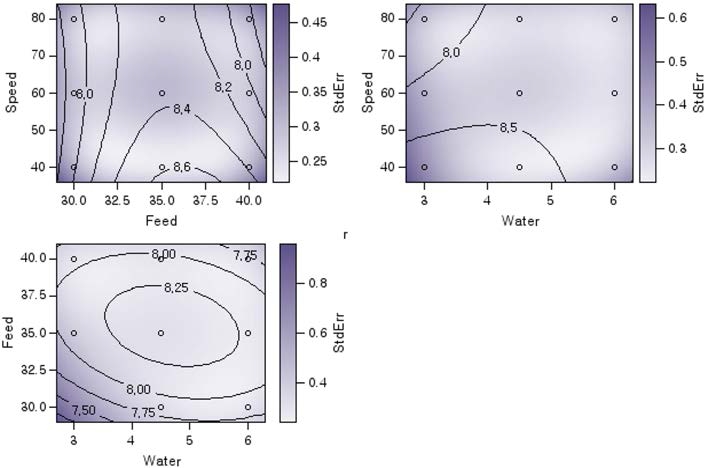
Response contour polt of screw speed, water and feed rate on the extracts yield. Speed; Screw speed (rpm). Feed; Feed rate (kg/h), Water; Water (kg/h), StdErr; Standard error.
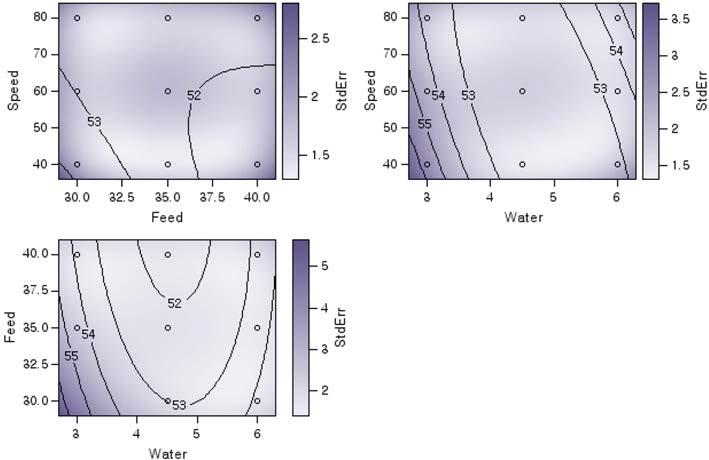
Response contour polt of screw speed, water and feed rate on the water solubility index. Feed; Feed rate (kg/h), Water; Water (kg/h), StdErr; Standard error.
3. 압출성형 조건에 따른 참당귀의 항산화성분과 항산화 활성
압출성형처리 조건에 따른 참당귀 압출성형물의 항산화 성 분의 함량을 측정한 결과와 참당귀 원료와 비교 분석하였다 (Table 8). 총폴리페놀 함량은 압출성형물 13번 처리구가 대조 구 함량 대비 40% 증가하여 유의적 (p < 0.05)인 차이를 나 타내었다. 또한 총폴리페놀 함량은 스크류 속도와 원료투입량 이 영향을 받아 폴리페놀은 스크류 속도, 원료투입량이 높을 수록 증가하는 경향을 확인할 수 있었다 (Table 9, Fig. 5). 따라서 선정된 최적조건은 압출성형처리 중 스크류 속도가 62.76 rpm이고, 참당귀 미분 투입량 34.79kg/h와 가수량 4.44kg/h이었다.
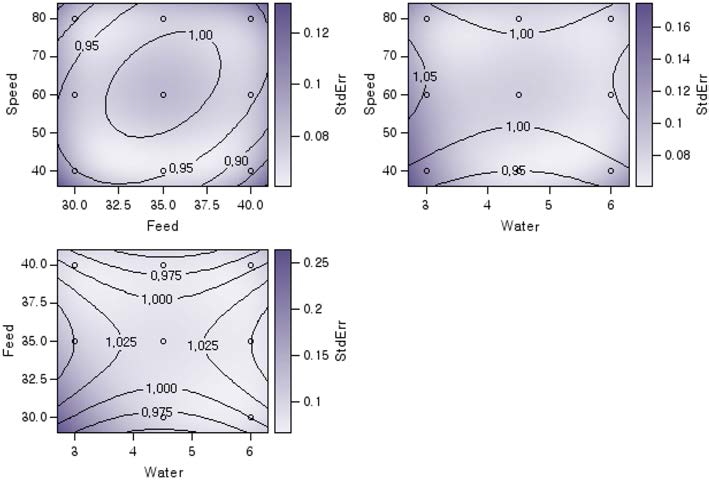
Response contour polt of screw speed, water and feed rate on the total polyphenol. Feed; Feed rate (kg/h), Water; Water (kg/h), StdErr; Standard error.
총플라보노이드 함량은 압출성형물 5번 처리구가 대조구 보 다 42.5% 높게 함유하고 있어 유의적 (p < 0.05)인 차이를 나 타내었다. 총플라보노이드 함량은 원료투입량, 가수량이 높을 수록 증가하는 경향을 확인할 수 있었다 (Table 9, Fig. 6). 압출성형처리 중 스크류 속도가 52.28 rpm이고, 참당귀 미분 투입량 33.59kg/h와 가수량 4.62kg/h일 때 최적조건으로 선 정되었다.

Analysis of variance for functional ingredients of Angelica gigas Nakai extract with extrusion conditions during processing.
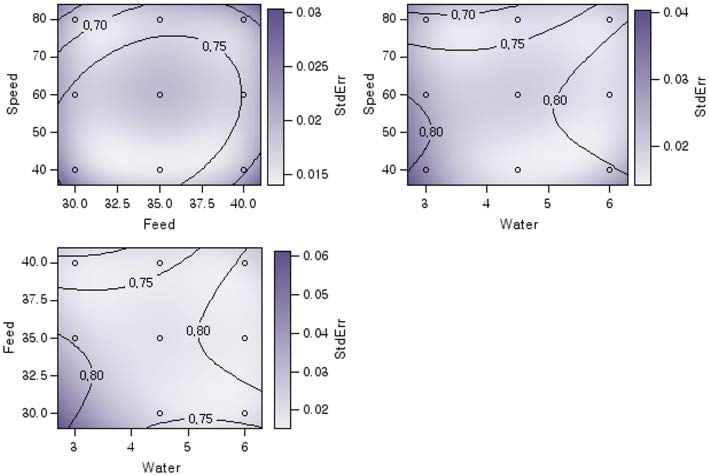
Response contour polt of screw speed, water and feed rate on the total flavonoids. Feed; Feed rate (kg/h), Water; Water (kg/h), StdErr; Standard error.
결합형 페놀 성분이 가열처리에 의해 유리형으로 전환되어 용출이 용이해지거나 고분자 페놀화합물이 저분자 페놀화합물 로 분해되어 총 페놀함량이 증가하기 때문이라는 연구보고와 유사한 결과를 나타내었다 (Choi et al., 2006; Kang et al., 1996; Turkmen et al., 2005). 참당귀와 압출성형 참당귀의 총폴리페놀, 총플라보노이드 등 항산화 성분 함량을 비교 분 석한 결과 참당귀를 압출성형처리 후 고온고압에서 추출할 경 우 세포벽 성분의 수용화가 극대화되는 것을 알 수 있었다. 즉, 비전분 탄수화물 추출률 및 전분의 붕괴는 압출성형에 의 한 물리적 전단에 의해 높일 수 있음을 확인하였다.
항산화 활성을 일반적으로 많이 알려진 DPPH에 의한 전자 공여능과 ABTS+ Radical 소거 활성을 측정하였다. 본 실험에 서 최적조건으로 선발된 참당귀 압출성형물을 DPPH에 의한 전자공여능으로 압출성형처리하지 않은 참당귀와 비교한 결 과, 참당귀 압출성형물 7번 처리구가 대조구 163.78μg/mL 대 비 14.59% 향상된 산화억제 효과를 나타내었다 (Table 10). 이러한 결과는 전자공여능이 phenolic acid와 플라보노이드 및 기타 페놀성 물질에 대한 항산화작용의 지표이며, 환원력이 큰 것일수록 전자공여능이 높다 (Seog et al., 2002). 또한 식물 체의 총폴리페놀 함량이 높을수록 전자공여능이 높은 경향이 있다고 알려져 있는데 (Choi et al., 2009; Kim et al., 2002), 압출성형물 7번 처리구의 총폴리페놀 함량도 대조구 대 비 유의적 (p < 0.05)으로 높았기 때문에 서로 연관이 있음을 확인할 수 있었으며, 이러한 결과는 압출성형 처리로 인해 세 포벽이 수용화되면서 저분자화된 참당귀 다당체의 활성에 의 한 결과라고 판단된다. 참당귀의 항산화 활성에 대한 반응표 면분석 결과, DPPH radical 소거 활성은 원료투입량, 가수량 이 높을수록 활성이 증가하는 경향을 확인할 수 있었다 (Table 10, Fig. 7). 따라서 선정된 최적조건은 압출성형처리 중 스크 류 속도가 54.54 rpm이고, 참당귀 미분 투입량 38.34kg/h와 가수량 4.57kg/h이다. 또한 ABTS+ radical 소거 활성은 압출 성형물 (처리구 7번, 스크류 속도 40 rpm, 원료투입량 30kg/ h, 가수량 4.5kg/h)의 ABTS+ radical 소거 활성 IC50 value가 110.07μg/mL로 압출처리하지 않은 참당귀의 122.69μg/mL에 대비 10.29% 향상된 항산화 활성의 효과를 보였다. Kim (2007)은 인삼을 압출성형하여 항산화 활성을 측정한 결과 유 의적 (p < 0.05)으로 증가되었다고 보고하였으며, 이는 압출성 형으로 인해 세포벽이 수용화되면서 인삼의 유용성분인 저분 자 proteoglucan과 산성다당체를 포함한 수용성 다당체가 용출 된 결과라고 보고하여 본 연구와 일치하였다. 이에 따라, 참당 귀의 ABTS+ radical 소거 활성은 DPPH radical 소거 활성과 같이 반응표면분석 결과 스크류 속도 (X1) (p < 0.01), 원료투입 량 (X2) (p < 0.001), 가수량 (X3) (p < 0.001)에 영향을 받는 것 으로 나타났으며, 스크류 속도 (X1)에 따른 F값이 2.43, 원료투 입량 (X2)는 11.91, 가수량 (X3)은 13.89로 나타나 원료투입량, 가수량이 높을수록 증가하는 경향을 확인할 수 있었다 (Table 11, Fig 8). 따라서 선정된 최적조건은 압출성형처리중 스크류 속도가 93.71 rpm이고, 참당귀 미분 투입량 28.67kg/h와 가수 량 9.9kg/h이며, 이때 항산화 활성은 Table 14에 나타내었다.

Analysis of variance for radical scavenging activities of Angelica gigas Nakai extract with extrusion conditions during processing.

Analysis of variance for decursin and decursinol angelate of Angelica gigas Nakai extract with extrusion conditions during processing.

Experimental data on proximate compositions, antioxidant components and antioxidant activities, and decursin of Angelica gigas Nakai by central composite design for response surface analysis.
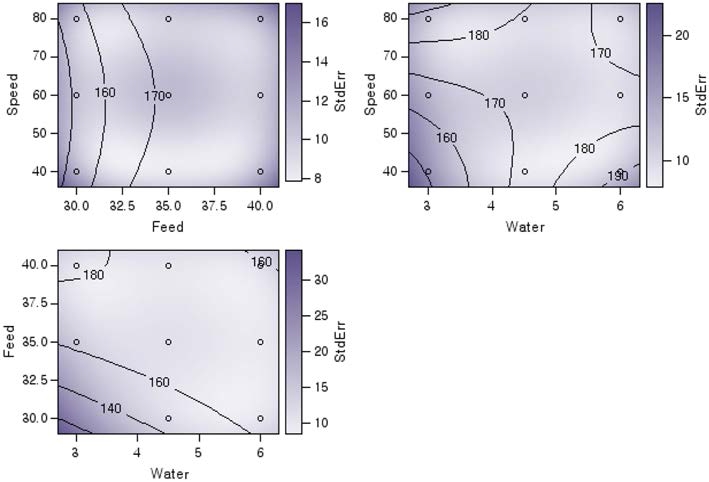
Response contour polt of screw speed, water and feed rate on the DPPH radical scavenging activity. Feed; Feed rate (kg/h), Water; Water (kg/h), StdErr; Standard error.
3. 압출성형물의 지표성분 함량
참당귀의 지표성분인 decursin과 decursinol angelate 함량은 압출성형물(처리구 3번, 스크류 속도 60 rpm, 참당귀 미분 투 입량 30kg/h, 가수량 6.0kg/h)이 6.37% 함량으로 대조구 함 량 5.31% 대비 16.64% 증가하여 유의적 (p < 0.05)인 차이를 나타내었다 (Table 12). 참당귀의 조파쇄 분말과 압출성형 분 말에 대한 decursin과 decursinol angelate의 추출함량을 비교 분석한 결과 압출성형시 유용성분 함량이 3~4배의 함량이 증 대되었다고 보고하여 본 연구와 유사한 결과를 나타내었다 (Kim et al., 2008). 이에 따라 decursin과 decursinol angelate 의 추출함량을 반응표면분석 결과 스크류 속도 (X1), 원료투입 량 (X2), 가수량 (X3) (p < 0.001)에 영향을 받는 것으로 나타 났으며, 스크류 속도 (X1)에 따른 F값이 10.59, 원료투입량 (X2)는 11.24, 가수량 (X3)은 12.93으로 나타나 원료투입량, 가 수량이 높을수록 증가하는 경향을 확인할 수 있었다 (Table 13, Fig 9). 따라서 선정된 최적조건은 압출성형처리 중 스크 류 속도가 93.71 rpm이고, 참당귀 미분 투입량 28.67kg/h 와 가수량 9.9kg/h이며, 이때 지표성분 함량은 Table 14에 나타 내었다.
감사의 글
본 연구는 농촌진흥청에서 주관하는 약용작물 고부가 소재 개발 및 나노기술 상품성 증진 연구(과제번호: PJ006921)의 연구비 지원으로 수행된 결과로 이에 감사드립니다.
REFERENCES
-
Abe, N, Murata, T, Hirota, A, Novel DPPH radical scavengers, bisorbicillinol and demethyltrichodimerol, from a fungus, Bioscience, Biotechnology and Biochemistry, (1998), 62, p661-666.
[https://doi.org/10.1271/bbb.62.661]

- Ahn, KS, Shim, WS, Kim, IH, Detection of anticancer activity from the ofAngelica gigas in vitro, Journal of Microbiology and Biotechnology, (1995), 5, p105-109.
- Ahn, KS, A study on the anticancer and imnunostimulating agents from the root ofAngelica gigasNakai, Ph. D. Thesis. Korea University, (1996), p39-48.
-
Anderson, RA, Conway, HF, Peplinski, AJ, Gelatinization of corn grits by roll cooking, extrusion cooking and steaming, Starch-Strke, (1970), 22, p130-135.
[https://doi.org/10.1002/star.19700220408]

- Association of Official Analytical Chemists(AOAC), Official Methods of Analysis, (1980), 13th ed, Arlington, Virginia, USA, Association of Official Analytical Chemists, p376-384.
- Cho, S, Takahashi, M, Toita, S, Cyong, JC, Suppression of adjuvant arthritis at by oriental herb(I), Shoyakagaku Zasshi, (1982), 36, p78-81.
- Choi, AJ, Jee, HK, Ko, BS, Kim, YH, Lee, SJ, Kim, CJ, Cho, YJ, Kim, CT, Solubilization of arabinogalactan by extrusion fromPortulaca oleraceaL. and itsin vitroantioxidant activity, Food Engineering Progress, (2009), 13, p169-175.
-
Choi, Y, Lee, SM, Chun, J, Lee, J, Influence of heat treatment on the antioxidant activities and polyphenolic compounds of Shiitake(Lentinus edodes) mush-room, Food Chemistry, (2006), 99, p381-387.
[https://doi.org/10.1016/j.foodchem.2005.08.004]

-
Dewanto, V, Wu, X, Liu, RH, Processed sweet corn has higher antioxidant activity, Journal of Agricultural and Food Chemistry, (2002), 50, p4959-4964.
[https://doi.org/10.1021/jf0255937]

- Fletcher, SI, Richmond, P, Smith, AC, Chemical components of red, white and extruded root ginseng, Journal of Food Engineering, (1985), 4, p291-312.
-
Gontard, N, Guilbert, S, Cuq, JL, Edible wheat gluten films: Influence of the main process variables on film properties using response surface methodology, Journal of Food Science, (1992), 57, p190-196.
[https://doi.org/10.1111/j.1365-2621.1992.tb05453.x]

- Ha, DC, Lee, JW, Kim, NM, Ryu, GH, Effect of barrel temperature and screw speed on characteristics of extruded raw ginseng, Journal of Ginseng Research, (2005), 29, p97-112.
- Han, SB, Kim, YH, Lee, CW, Park, SM, Lee, HY, Aan, KS, Kim, HM, Characteristics immunostimulation by angelan isolation fromAngelica gigasNakai, Immunopharmacology, (1998), 40, p39-48.
- Hwang, JK, Kim, JT, Hong, SI, Kim, CJ, Solubilization of plant cell walls by extrusion, Journal of the Korean Society of Food Science and Nutrition, (1994), 23, p358-370.
- Hwang, JB, Yang, MO, Comparison of chemical components ofAngelica gigasNakai andAngelica acutilobaKitagawa, Korean Journal of Food Science and Technology, (1997), 29, p1113-1118.
- Kang, YH, Park, YK, Lee, GD, The nitrite scavenging and electron donating ability of phenolic compounds, Korean Journal of Food Science and Technology, (1996), 28, p232-239.
- Kelly, GS, Larch arabinogalactan: Clinical relevance of a novel immune-enhancing polysaccharide, Alternative Medicine Review, (1999), 4, p96-103.
- Kim, BS, Ryu, GH, Effect of die temperature and dimension on extract characteristics of extruded white ginseng, Journal of the Korean Society of Food Science and Nutrition, (2005a), 34, p544-548.
- Kim, BS, Ryu, GH, Effect of die temperature and on puffing of extruded white and red ginseng, Journal of the Korean Society of Food Science and Nutrition, (2005b), 34, p1109-1113.
- Kim, HK, Choi, YJ, Kim, KH, Functional activities of microwave-assisted extracts fromFlammulina velutipes, Korean Journal of Food Science and Technology, (2002), 34, p1013-1017.
- Kim, HS, Park, HJ, A study of the effects of the root components ofAngelica gigas, Korea Journal of Pharmacognosy, (1980), 24, p173-179.
-
Kim, HS, Kim, TW, Kim, DJ, Lee, JS, Kim, KK, Choe, M, Antioxidant activities and α-glucosidase inhibitory effect of water extracts from medicinal plants, Korean Journal of Medicinal Crop Science, (2013), 21, p197-203.
[https://doi.org/10.7783/kjmcs.2013.21.3.197]

-
Kim, KM, Jung, JY, Hwang, SW, Kim, MJ, Kang, JS, Isolation and purification of decursin and decursinol angelate inAngelica gigasNakai, Journal of the Korean Society of Food Science and Nutrition, (2009), 38, p653-656.
[https://doi.org/10.3746/jkfn.2009.38.5.653]

- Kim, NS, Lim, DJ, Kim, DE, Sun, HJ, Kang, WS, Ko, SH, Increased yield and decrusin content in powder ofAngelica gigasby extrusion process, Korean Journal of Medicinal Crop Science, (2008), 16, p184-185.
- Kim, SH, Effect of the Extruded Ginseng on Antioxidant Activity, Journal of the East Asian Society of Dietary Life, (2007), 17, p402-408.
- Kim, YG, An, TJ, Yeo, JH, Hur, M, Park, YS, Cha, SW, Song, BH, Lee, KA, Effect of eco-friendly organic fertilizer on growth and yield ofAngelica gigasNakai, Korean Journal of Medicinal Crop Science, (2014), 22, p127-133.
- Matthee, V, Appleddrf, H, Effect of extrusion-cooking on vegetable fiber, Journal of Food Science, (1978), 43, p1344-1345.
- Matsumoto, K, Kohno, S, Ojima, K, Tezuka, Y, Kadota, S, Watanabe, H, Effect of ethylenechloride-soluble fraction of Japanese Angelica root extract ligustilde and butylidenphthalide on pentibarbital sleep in group-housed and socially isolated mice, Life Sciences, (1998), 38, p112-119.
- Ng, A, Lecain, S, Parker, ML, Smith, AC, Waldron, KW, Modification of cell-wall polymers of onion waste III. Effect of extrusion-cooking cell-wall material of outer fresh tissues, Carbohydrate Polymers, (1999), 39, p341-349.
- Park, BH, Cho, HS, Park, SY, A study on the antioxidative effect and quality characteristics of cookies made withLycii fructuspowder, Korean Journal of Food Cookery Science, (2005), 21, p94-102.
-
Ralet, MC, Thibalt, JF, Extraction and characterization of very highly methylated pectins from lemon cell walls, Carbohydrate Research, (1994), 260, p283-296.
[https://doi.org/10.1016/0008-6215(94)84046-6]

- Roberta, RE, Pellegrini, N, Proteggente, A, Pannala, A, Yang, M, Rice Evans, C, Antioxidant activity applying an improved ABTS radical cation decolorization assay, Journal of Free radical Biology & Medicine, (1999), 26, p1231-1237.
- Ryu, GH, Recent trend in red ginseng manufacturing process and characteristics of extruded red ginseng, Food Engineering Progress, (2007), 11, p1-10.
- Ryu, GH, Remon, JP, Extraction yield of extruded ginseng and granulation of its extracts by cold extrusion spheronisation, Journal of the Korean Society of Food Science and Nutrition, (2004), 33, p899-904.
- Ryu, KS, Hong, ND, Kim, YY, Studies on the coumarin constituents of the root ofAngelica gigasNakai Isolation of decursinol angelate and assay of decursinol angelate and decursin, Korean Journal of Pharmacognosy, (1990), 21, p64-68.
- Seong, HM, Seo, MS, Kim, SR, Park, YK, Lee, YT, Characteristics of barley polyphenol extract(BPE) separated from pearling by products, Korean Journal of Food Science and Technology, (2002), 34, p775-779.
- Seong, NS, Lee, SW, Kim, KS, Lee, ST, Environmental variation of decursin content inAngelica gigas, Korean Journal of Crop Science, (1993), 38, p60-65.
- Swain, T, Hillis, WE, Oritega, M, Phenolic constituents ofPtunus domestica. I. Quantitative analysis of phenolic constituents, Journal of the Science of Food and Agriculture, (1959), 10, p83-88.
- Turkmen, N, Sari, F, Velioglu, YS, The effects of cooking methods total phenolic and antioxidant activity of selected green vegetables, Food Chemistry, (2005), 93, p713-718.
-
Ye, YN, Liu, ELS, So, HL, Cho, CM, Sheng, HP, Lee, SS, Cho, CH, Protective effect of polysaccharides enriched fraction fromAngelica sinensison hepatic injury, Life Science, (2001), 69, p637-646.
[https://doi.org/10.1016/s0024-3205(01)01153-5]

- Yoon, SR, Lee, MH, Park, JH, Lee, IS, Kwon, JH, Lee, GD, Change in physicochemical compounds with heating treatment of ginseng, Journal of the Korean Society of Food Science and Nutrition, (2005), 34, p1572-1578.
- Yu, HS, Park, CH, Park, CG, Kim, YG, Park, HW, Seong, NS, Growth characteristics and yield of the three species of genus Aangelica, Korean Journal of Medicinal Crop Science, (2004), 12, p43-46.
